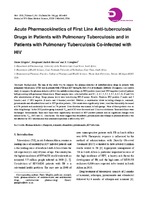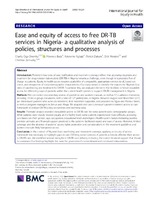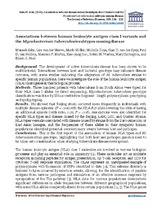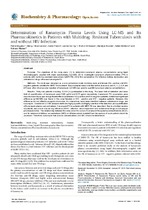Acute pharmacokinetics of first line anti-tuberculosis drugs in patients with Pulmonary Tuberculosis and in patients with Pulmonary Tuberculosis co-infected with HIV
Abstract
The aim of this study was to compare the pharmacokinetics of antituberculosis drugs in patients with
pulmonary tuberculosis (PTB) and in patients with PTB and HIV during the first 24 h of treatment. Designed as a case-control
study, it compares the pharmacokinetics of first line antituberculous drugs, in HIV-positive (cases) and HIV-negative (control) patients
both presenting with pulmonary tuberculosis. Blood samples were collected before and 0.5, 1, 1.5, 2, 2.5, 3, 3.5, 4, 4.5, 8, 12 and 24 h
after administration of drugs. Drugs plasma levels were tested using HPLC assays. Results: Fourteen HIV positive (7 males and 7
females) and 17 HIV negative (9 males and 8 females) enrolled. Rifafour, a combination tablet including rifampicin, isoniazid,
pyrazinamide and ethambutol was used in HIV positive patients, CD4 counts were significantly lower, renal function mildly decreased
in 85% patients and moderately decreased in 7% patients. Liver function was normal in both groups. None of these patients was on
other drug therapy. In the HIV positive group isoniazid T1/2 and AUC were decreased and Cl increased whereas Tmax and Cmax were
unchanged. Pyrazinamide Tmax and Cmax were significantly decreased in HIV positive patients and no significant changes were
noticed in the T1/2, AUC and CL. Conclusion: The study suggest that ethambutol, pyrazinamide and rifampicin pharmacokinetics was
not affected by HIV infection and that isoniazid disposition is affected by HIV.
Related items
Showing items related by title, author, creator and subject.
-
Ease and equity of access to free DR-TB services in Nigeria- a qualitative analysis of policies, structures and processes
Oga-Omenka, Charity; Bada, Florence; Agbaje, Aderonke; Dakum, Patrick; Menzies, Dick; Zarowsky, Christina (BioMed Central Ltd, 2020)Introduction: Persistent low rates of case notification and treatment coverage reflect that accessing diagnosis and treatment for drug-resistant tuberculosis (DR-TB) in Nigeria remains a challenge, even though it is ... -
Associations between human leukocyte antigen class I variants and the Mycobacterium tuberculosis subtypes causing disease
Salie, Muneeb; van der Merwe, Lize; Möller, Marlo; Daya, Michelle; van der Spuy, Gian D.; van Helden, Paul D.; Martin, Maureen P.; Gao, Xiao-jiang; Warren, Robin M.; Carrington, Mary; Hoal, Eileen G. (Oxford University Press, 2013)BACKGROUND. The development of active tuberculosis disease has been shown to be multifactorial. Interactions between host and bacterial genotype may influence disease outcome, with some studies indicating the adaptation ... -
Determination of kanamycin plasma levels using LC-MS and its pharmacokinetics in patients with multidrug-resistant tuberculosis with and without HIV-infection
Mugabo, Pierre; Abaniwonda, Mercy, I.; Theron, Danie; Hassan, Shafick, M.; Stander, Marietjie; Van Zyl, Leonie; McIlleron, Helen; Madsen, Richard (OMICS, 2015)The objectives of the study were: (1) to determine kanamycin plasma concentrations using liquid chromatography coupled with mass spectrometry (LC-MS), (2) to investigate kanamycin pharmacokinetics (PK) in patients with ...




